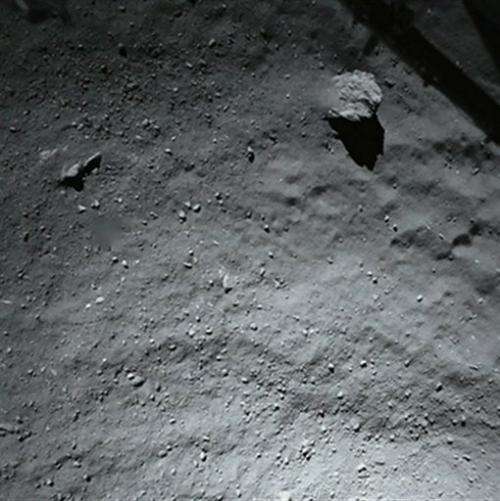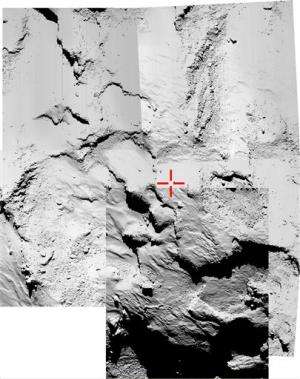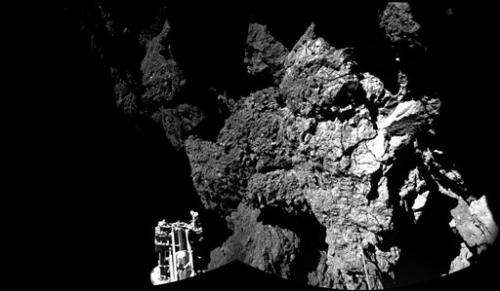European probe plants thermometer on comet

Europe's Philae lander is doing well and has succeeded in planting a thermometer in the comet where it touched down this week, the European Space Agency said Friday.
Scientists have received a steady stream of data from the lander, which on Wednesday became the first spacecraft to touch down on a comet and has since sent its first images from the surface of the body, known as 67P/Churyumov-Gerasimenko.
However, their job is complicated by the fact that Philae landed next to a cliff that is blocking sunlight from its solar panels.
Planting a thermometer in the surface was Philae's first so-called "mechanical operation" but ESA says it will hold off on any more for now. Scientists hope to drill into the comet to extract some of the material buried beneath the surface of the comet, which is streaking through space at 41,000 mph (66,000 kph) some 311 million miles (500 million kilometers) from Earth.
The lander's primary battery only has power for another day or so and mission controllers are contemplating how they might realign it so that the solar panels can charge the craft. An update on the mission from ESA was scheduled for later Friday.
Two harpoons that should have anchored the washing machine-sized Philae to the surface weren't deployed during Wednesday's landing.
That caused the lander to bounce off the comet and drift through the void for two hours before touching down again. After a second, smaller bounce, scientists believe it came to rest in a shallow crater on the comet's 2½ mile (4-kilometer) wide body, or nucleus.
Communication with the lander is slow, with signals taking more than 28 minutes to travel between Earth and Philae's mother ship, the Rosetta orbiter flying above the comet.
-

This five-image montage of Rosetta's OSIRIS narrow-angle images , released by the European Space Agency ESA on Thursday Nov. 13, 2014 , is being used to try to identify the final touchdown point of Rosetta's lander Philae. The images were taken around the time of landing on November 12 when Rosetta was about 18 km (11 miles) from the center of Comet 67P/Churyumov-Gerasimenko (about 16 km from the surface). ESA digitally marked the supposed landing area with a cross. The lander scored a historic first Wednesday, touching down on comet 67P/Churyumov-Gerasimenko after a decade-long, 6.4 billion-kilometer (4 billion-mile) journey through space aboard its mother ship, Rosetta. The comet is streaking through space at 41,000 mph (66,000 kph) some 311 million miles (500 million kilometers) from Earth. (AP Photo/ESA/Rosetta/Philae) -

The combination photo of different images taken with the CIVA camera system released by the European Space Agency ESA on Thursday Nov. 13, 2014 shows Rosetta's lander Philae as it is safely on the surface of Comet 67P/Churyumov-Gerasimenko, as these first CIVA images confirm. One of the lander's three feet can be seen in the foreground. Philae became the first spacecraft to land on a comet when it touched down Wednesday on the comet, 67P/Churyumov-Gerasimenko. (AP Photo/Esa/Rosetta/Philae)
© 2014 The Associated Press. All rights reserved.





















